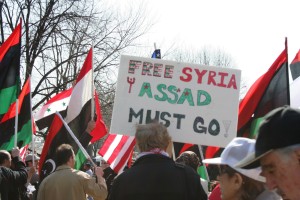By: Timothy Aderman
The war in Syria nears the four and a half year mark with no end in sight. It is easy to judge a situation in hindsight. Some pundits argue that arming Syrian moderates, when clearly delineated lines existed between pro-government forces and rebels, would have successfully and quickly removed Assad. This theory, tinged with U.S.’ special brand of hubris, suggests that U.S. arms would have expedited the removal of Assad. Perhaps a limited contingent from JSOC (Joint Special Operations Command) could have been covertly deployed to assist in training. Assad’s downfall would be the catalyst for Syrians to enjoy the fruits of the democratic process and circumvent a long, drawn-out war with high civilian casualty rates.
At the time, Assad’s removal seemed quite plausible. Protests against his regime were met with violence. In return, protestors began to arm themselves. Reports of Syrian officers defecting to the rebel cause for refusing to shoot unarmed civilians seemed in line with the general theme of the Arab Spring, that being a popular revolt against oppressive regimes. Indeed, the Arab Spring was one scented with the people’s will.
With the breathtaking demonstrations in Egypt’s Tahrir Square still sending shockwaves throughout MENA (Middle East, North Africa region), a misinformed U.S. foreign policy asked the wrong questions. Assuming today’s pundits are correct in thinking that the U.S. should have maintained an interventionist policy and armed Syrian moderates, the question asked should not have been whether U.S. arms would inadvertently get into the hands of Al-Qaeda of the Arabian Peninsula or other radical elements infiltrating Syrian rebel forces. Remember, this was at a time when Daesh wasn’t even “junior varsity” yet. Instead, the foreign policy question should have been trying to estimate whether or not Assad would actually be removed and whether or not Iran and other regional forces would align with his regime against Syrian rebels.
As Syria spiraled into civil war, U.S. foreign policy stalled out. The Iraq War, or Second Gulf War, officially ended in December of 2011. This was exactly one year after Mohamed Bouaziz self-immolated in Tunis, sparking the Arab Spring in December of 2010. Three months after Mohamed’s selfless act, Syrians began protesting the Assad regime. By the time all-out civil war was occurring in Syria in 2012, the U.S. had fully withdrawn from Iraq. The U.S. public would never have supported troop deployments after the long and frustrating Iraq War that left almost 4,500 U.S. service members killed. Essentially, the option for troop deployments was not on the table. With this in mind, arming rebels would have been the most effective means of support.
The U.S. overemphasized the bad taste of having armed Afghan Mujahideen during the 1980s. These Islamic fundamentalists armed with U.S. Stinger missiles portrayed in Tom Hanks’ Charlie Wilson’s War first used shoulder-fired weapons against Russian helicopters. Upon arrival of U.S. troops after the events of 9/11, a severely limited number of Stingers are documented to have been fired on U.S. military helicopters in Afghanistan. There was fear that intelligence on the composition of those fighting Assad’s more secular regime were Islamic fundamentalists, the same groups of people prescribing to very un-American beliefs. Ironically, strong ideological comparisons could be made between the Afghan Mujahideen, some of whom evolved into the Taliban, and, decades later, the hard-liners that intelligence said had infiltrated Syrian rebels.
There seems to be a patriotic yet cumbersome remembrance of indirectly fighting Russia through the arming of Afghanistan’s Mujahideen. Cumbersome in that, decades later, those U.S. weapons would be turned against the U.S. The idea of our weapons turned against the U.S. would surely not be repeated in Syria.
U.S. support for Syrian rebels stalled out. Troops could not be deployed and there was fear of arming rebels fighting a repressive regime, a regime backed by Iran. So, the response was to wait.
Few predicted the rise of ISIS but the lack of decisive, strategic decision-making early on in 2012 has had a domino effect. Now, ISIS soldiers have caused havoc throughout both Syria and Iraq. The recent fall of Ramadi, a mere 1 ½ hour drive from Baghdad is terrifying. If the thought of arming Al-Qaeda to fight the Assad regime was frightening, the question of whether or not Baghdad will fall to ISIS should be just as, if not more frightening.
Photo: workerspower.co.uk

